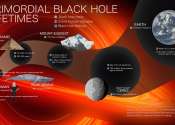NASA study provides new look at orbital debris, potential solutions
New data analysis indicates that NASA and its partners could have more cost-effective methods for dealing with the growing issue of orbital debris than previously thought.

New data analysis indicates that NASA and its partners could have more cost-effective methods for dealing with the growing issue of orbital debris than previously thought.
Space Exploration
May 20, 2024
0
42

On Sunday, December 11, at 9:04 a.m. PST (12:04 p.m. EST, 17:04 UTC) NASA's Juno spacecraft will make its third science flyby of Jupiter.
Space Exploration
Dec 9, 2016
10
1450

Astronomers have discovered black holes ranging from a few times the sun's mass to tens of billions. Now a group of scientists has predicted that NASA's Nancy Grace Roman Space Telescope could find a class of "featherweight" ...
Astronomy
May 7, 2024
0
148

NASA's Mars Curiosity rover just hit a new milestone: its two-thousandth Martian day, or sol, on the Red Planet. An image mosaic taken by the rover in January offers a preview of what comes next.
Space Exploration
Mar 23, 2018
3
728

Billions of years ago when the planets of our solar system were still young, Mars was a very different world. Liquid water flowed in long rivers that emptied into lakes and shallow seas. A thick atmosphere blanketed the ...
Space Exploration
Nov 13, 2013
21
0

(Phys.org) —NASA's Voyager 1 spacecraft has experienced a new "tsunami wave" from the sun as it sails through interstellar space. Such waves are what led scientists to the conclusion, in the fall of 2013, that Voyager had ...
Space Exploration
Jul 8, 2014
9
0

(Phys.org) -- The NASA/ESA Hubble Space Telescope has captured this view of the dwarf galaxy UGC 5497, which looks a bit like salt sprinkled on black velvet in this image.
Astronomy
Jun 17, 2012
14
0

Astronomers have found evidence for a faded electron cloud "coming back to life," much like the mythical phoenix, after two galaxy clusters collided. This "radio phoenix," so-called because the high-energy electrons radiate ...
Astronomy
Aug 27, 2015
3
758

NASA recently concluded the final mission of its Spacecraft Fire Safety Experiment, or Saffire, putting a blazing end to an eight-year series of investigations that provided insights into fire's behavior in space.
Space Exploration
Feb 15, 2024
0
37

Astronomers have made a thorough forensic study of a star that was torn apart when it ventured too close to a giant black hole and then had its insides tossed out into space.
Astronomy
Aug 22, 2023
0
5103